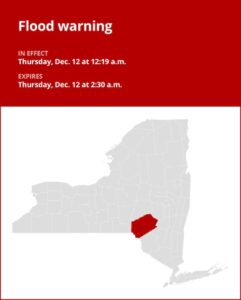At 12:46 a.m. on Thursday, the National Weather Service issued a flood warning for Rensselaer and Washington counties, which was in effect from 6 a.m. to 4 p.m.
According to the weather service, “Minor flooding is forecast for Hoosic River at Eagle Bridge.”
“The flood stage is at 11.0 feet. The weather service also notes that there is water on County Route 103 between Route 67 and the covered bridge.
Deciphering advisories, watches, and warnings: Understanding weather alerts
-
Flash flood warning: Take action!
When a flash flood is approaching or already happening, a warning is sent. Get to high ground right away if you’re in a flood-prone location. A flash flood is a quick, intense flood that can form in a matter of minutes to hours. Even in places that don’t get rain right away, flash floods can happen.
-
Flood warning: Take action!
When flooding is about to occur or has already started, a flood warning is issued.
-
Flood advisory: Be aware:
When flooding is not predicted to be severe enough to warrant a warning, a flood advisory is issued. But if care is not taken, it could result in circumstances that endanger life and/or property and cause a great deal of discomfort.
-
Flood watch: Be prepared:
When the weather is conducive to flooding, a flood watch is issued. Flooding is not guaranteed, but it is a possibility.
Staying safe during a flood: Recommendations from the weather service
Knowing and adhering to the weather service’s flood safety recommendations can be extremely helpful when camping in low-lying areas or in places that are prone to flooding:
Go to a higher location:
Moving to higher ground is the first line of defense if you live in an area that floods easily or are camping in a low-lying area.
Respect evacuation directives:
Immediately comply with any evacuation orders issued by local authorities. Make sure your house is locked before you leave.
Cut off appliances and utilities:
Disconnect your appliances and utilities if you have the time. By taking this precaution, electrical dangers during flooding are reduced.
Avoid drowned places and flooding basements:
Stay away from rooms with electrical outlets or cords that are submerged in water or basements. Electrical accident prevention is essential.
Quick evacuation to keep you safe:
Evacuate right away if you see sparks or hear popping, crackling, snapping, or buzzing noises. Avoid going into water that might be electrically charged.
Avoid going on foot in floodwaters:
Even if floodwaters seem shallow, you should never try to go over them. You can be swept off your feet with power by just 6 inches of swift-moving water.
If you’re stuck, look for high ground:
If you find yourself caught by flowing water, move to the highest spot you can and dial 911 to reach rescue personnel.
Flooding is a possibility when there is a lot of rain, especially in low-lying or flood-prone locations. Even if it looks shallow, it is imperative that you never drive across water on the road. The weather service claims that most cars can be washed away by as little as 12 inches of swift-moving water. Be knowledgeable and ready to stay safe.
Driving through downpours: Safety guidelines for wet roads
Flooding and dangerous driving conditions increase when heavy rain starts. Being ready is crucial, regardless of the duration of the rainfall or the rate of runoff. The weather service has provided the following important safety advice to help you stay safe during periods of severe rain:
Watch out for flooding rivers:
Avoid parking or strolling close to drainage ditches or culverts during periods of intense rain, since the swift-moving water can be quite dangerous.
Keep your distances from other vehicles safe:
Use the two-second rule to maintain a safe distance from the car in front of you and allow an extra two seconds in heavy rain.
Slow down and drive with care:
Reduce your speed if it’s raining and the roads are wet. Reduce your speed gently by taking your foot off the accelerator. Never apply the brakes abruptly since this could cause the vehicle to slide.
Pick your lane carefully:
To reduce the chance of hydroplaning, stay in the middle lanes. Water is more likely to accumulate in outside lanes.
Prioritize visibility:
Enhance your visibility in heavy rain by turning on your headlights. Watch out for vehicles in blind spots, as rain-smeared windows can obscure them.
Be cautious on slick roads:
During the first half hour after the rain starts, exercise additional caution. The road becomes slick when water combines with dirt and oil on the surface.
Stay a safe distance away from big cars:
Tire spray from big vehicles and buses can make it harder to see. Pass them quickly and safely, and refrain from tailgating.
Be mindful of your wipers:
-
Overloaded wiper blades can hinder visibility. If rain severely limits your sight, pull over and wait for conditions to improve. Seek refuge at rest areas or protected spots.
-
When stopping by the roadside is your only option, position your vehicle as far off the road as possible, ideally beyond guardrails. Keep your headlights on and activate emergency flashers to alert other drivers of your position.
Taking these safety measures will significantly improve your road safety while it’s raining a lot. For a safe trip, keep yourself updated on weather conditions and follow local authorities’ instructions.
United Robots offers a service called Advance Local Weather Alerts that gathers the most recent information from the National Weather Service using machine learning.
Note: Every piece of content is rigorously reviewed by our team of experienced writers and editors to ensure its accuracy. Our writers use credible sources and adhere to strict fact-checking protocols to verify all claims and data before publication. If an error is identified, we promptly correct it and strive for transparency in all updates, feel free to reach out to us via email. We appreciate your trust and support!







+ There are no comments
Add yours